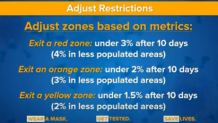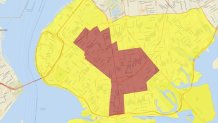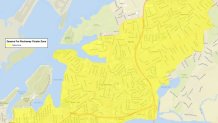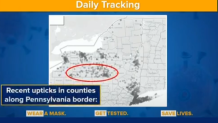What to Know
- Gov. Andrew Cuomo unveiled new benchmarks Wednesday for reopening cluster zones; they focus on positivity rates, sources of new cases, hospitalization and new case trends and enforcement
- Based on those new benchmarks, he eased restrictions in some Queens hotspots and intensified them in Brooklyn's red zone; there are no changes to the maps in Orange, Rockland or Broome counties
- Cuomo also said he's concerning about new micro-clusters breaking out on the New York/Pennsylvania border; those appear at least in part tied to community spread, he said, and will amp up testing
Gov. Andrew Cuomo has realigned his cluster zone maps, announcing Wednesday that virus control measures will be eased in two red zone sections of Queens and intensified in Brooklyn's red zone, given ongoing infection rate and compliance issues there.
Nonessential businesses will be permitted to reopen Thursday in areas where red zone restrictions were lifted. Schools that switched all-remote in those areas as well as those no longer in orange zones can reopen in person Monday, and Mayor Bill de Blasio said while he can't predict the future, he is "very confident" that those schools will be able to stay open.
"When we see progress, we adjust the target," the governor said. (Here's a quick look at all the updated cluster zone maps and a quick reminder of the rules.)
Combined, the initial red zone areas in Brooklyn, Queens and Rockland and Orange counties now average a 4.5 percent positivity rate, compared with a 7.9 percent positivity rate the last week of September. That soaring rate at the end of September is what prompted the renewed restrictions, which were initially put in place for two weeks. That window expires Thursday.
"I think it's been a wake-up call and a lot of folks will act differently from this point on," de Blasio said.
Going forward, the cluster zone maps will be reassessed over a moving 10-day period, Cuomo said. He revealed benchmarks for cluster zone reopenings Wednesday that differ substantially from the standards he used for the phased statewide reopening process earlier this year.
Most of the benchmarks hinge on positivity rates (see below). Cuomo said he will also look at hospitalizations trends, the sources of new cases (whether they stem from congregate settings), local enforcement and community cooperation. The governor emphasized those last two points as key ways to potentially avoid or limit more clusters.
"A cluster does not happen unless two things happen: A lack of compliance and lack of enforcement," Cuomo said. "If you have no compliance and you have no enforcement, you know what you have? Spread. That's it. There's no rocket science here. How did it happen? People didn't follow the rules. The government didn't enforce the rules and now you have spread."

What Changes Where?
Brooklyn's orange zone areas will move yellow, which allows schools to reopen with mandatory weekly testing, while its yellow zone areas will remain yellow. In Queens, the north red zone and the orange zone both turn yellow, while the north yellow zone remains as is for now. Cuomo said he also adjusted the cluster zone map to capture a recent uptick in the Ozone Park neighborhood.

In the Far Rockaway cluster, the red and orange zones also turn yellow while the yellow zone remains in its current precautionary categorization. The situation hasn't sufficiently improved in Rockland County, despite some progress, Cuomo said. Those maps don't change. Orange and Broome counties' maps don't change either.


Red zones previously covered 2.8 percent of New York's population, but for a time, that 2.8 percent of the population was accounting for a fifth or more of new daily cases statewide. That same percentage drove about 70 percent of the state's new hospital admissions since early September. As of Wednesday, state hospitalizations totaled 950, the highest number since June 25. The state also recorded more than 2,000 new infections in a single day for the first time since May 20 (as recently as late August, the state was averaging fewer than 600 new cases per day).
It wasn't immediately clear what percentage of the state population was covered by the newly realigned red zones. Cuomo said Wednesday the current red zone areas had a 6.61 percent positivity rate Tuesday. The daily statewide infection rate excluding them was 1.42 percent, which is the first time in months it has ticked up that high without the hotspots. When asked Wednesday whether he thought the clusters were turning into community spread, Cuomo repeatedly said "no" -- and emphasized that New York's infection rate remains one of the nation's lowest.

The Out-of-State Threat — And the Fall
According to Wednesday data from Johns Hopkins, New York has the third-lowest infection rate in the nation (1.16 percent), based on a seven-day rolling period. Only Massachusetts (1.13 percent) and Maine (0.52 percent) have lower positivity rates on a weekly basis. The state with the highest, Nevada, has a rolling positivity average more than 50 times higher than New York's (58.84 percent).
New Jersey and Connecticut are among the 15 lowest-transmission rate states -- 2.71 percent and 1.92 percent, respectively -- even as they battle a surge in new cases that has them both meeting the new-cases-per-100,0000 threshold to land on New York's travel quarantine list, along with Pennsylvania.
The Pennsylvania/New York border has become particularly problematic, Cuomo said Wednesday, noting he is tracking new micro-clusters breaking out there. Evidence indicates some of those micro-clusters are tied to specific clusters, but it also shows a community spread factor, which is more problematic. The governor said he would focus on enhancing testing efforts in those areas and applied a yellow zone rating to part of Steuben as well as Chemung counties.

Cuomo said there will be no travel restrictions among the four states, calling that impractical and potentially disastrous for the local economies. He said Wednesday he would talk to global experts about testing and any alternate methodologies to quarantine, though didn't immediately elaborate on what those might be. A day earlier, Cuomo urged people to avoid non-essential tri-state travel.
New Jersey Gov. Phil Murphy, who said Wednesday he would self-isolate after being in contact with a COVID-positive person, and Connecticut Gov. Ned Lamont agreed on that non-essential travel point. There remains no quarantine requirement across tri-states and no penalties apply for traveling between them.
Tracking Coronavirus in Tri-State
Cuomo has repeatedly said he expects more viral flare-ups in New York through the fall, given the national context and the general stressors that accompany the season: schools, flu, more indoor activities.
"I think you're going to see more micro clusters in New York, you're going to see a higher rate in New York, you're going to see a higher rate nationwide and you're going to see a higher rate globally," Cuomo said.
The governor has said the same micro-cluster strategy, targeting viral increases on a block-by-block level, will be the same method he uses to attack those as they emerge over the next few months.
"Trace it back to where it starts. Find the small outbreak, the small cluster, and jump on it," Cuomo said. "Because these are so small, these areas, they’re going to flare-up. And then you run and you put them out. The next day, there’s another flare-up.”
He says he hopes a vaccine will come by winter, though delivering and administering that to 20 million (or as many as 40 million) people will be another challenge entirely. The governor said Wednesday he didn't believe one would be deliverable by December.
"Winter is going to be the season of the vaccine. That may very well be the most challenging operation government has had to perform all through COVID. You think testing was hard? It pales in comparison to administering vaccines," Cuomo said. "Just to put the numbers, we did 12 million COVID tests over seven months, moving heaven and earth. We have to do 40 million vaccinations."
Earlier in the day, de Blasio said New York City was working with the state on a vaccine implementation plan for the five boroughs. He called an effective vaccine "the gateway" to the city's post-COVID rebirth.
Until one comes, and it is proven to be safe, the mayor is focused on maintaining progress in hotspots and citywide. More than 23,000 COVID tests have been done in cluster zones since Sept. 30, he said.
And while both de Blasio and Cuomo continue to say how important it is to take the virus seriously, even if significant fatigue levels may be setting in, there is no reason to panic if a micro cluster pops up.
"Don't get unduly alarmed by a micro-cluster. The infection rate in our micro-clusters is lower than the infection rate of most states. We talk about four or five percent in a micro-cluster," Cuomo said. "Many states would love to have the infection rate that we have in our micro-clusters as their statewide rate."



